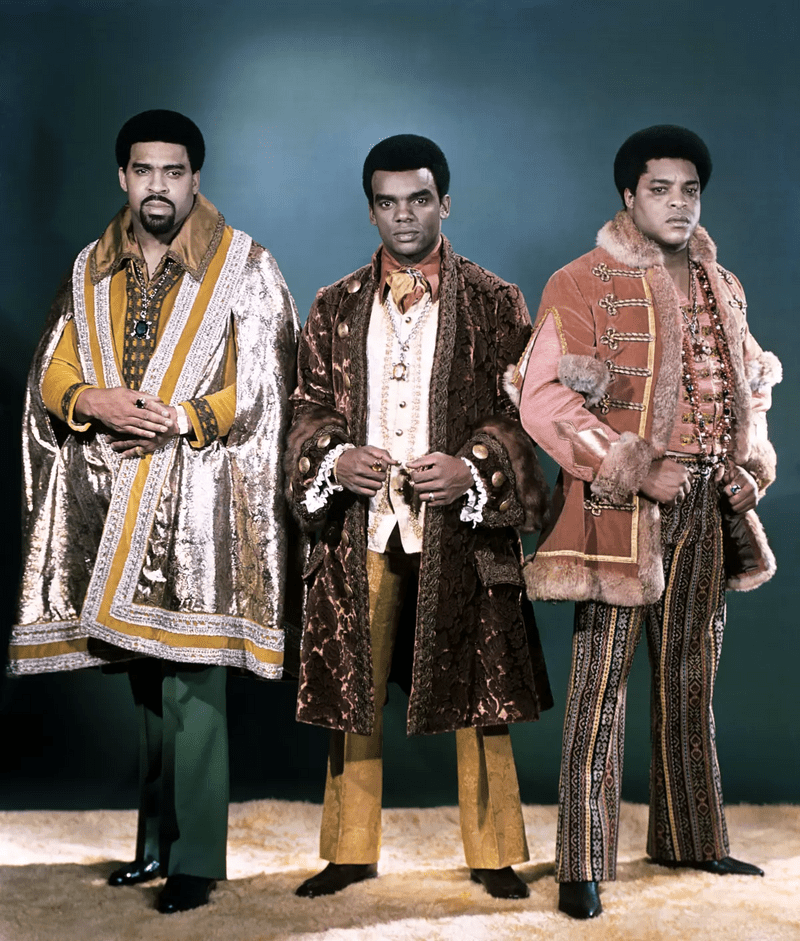Introduction
The Isley Brothers was formed in 1954, originally as a vocal trio consisting of brothers O’Kelly Jr., Rudolph and Ronald Isley – another brother Vernon joined them shortly before his tragic death from a hit-and-run incident. First signed to RCA in the late 1950s, their trio first charting single was “Shout”, which although not a big hit, has become one of their most classic tunes over time. Another one of their more well-known originals “Twist and Shout” finally made it to the Top 20 pop chart in 1962 just before the Beatles’ most famous version outsold it. Because of the success of “Twist And Shout” the Brothers were able to establish their own label, but it proved to be short-lived. Then they signed to Motown and next to T-Neck label, the last which they jumpstarted their run of hit singles with “It’s Your Thing” in 1969.
Other big hits include “Love The One You’re With”, “Lay Away”, “Pop That Thang”, “Work To Do”, “That Lady”, “What It Comes Down To”, “Summer Breeze”, “Live It Up”, “Midnight Sky”, “Fight The Power”, “Who Loves You Better”, “Harvest For The World”, “The Pride”, “Take Me To The Next Phase”, “I Wanna Be With You”, “Don’t Say Goodnight (It’s Time For Love)”, “Inside You”, “Choosey Lover” and “Between The Sheets”, and so many others – all released on T-Neck label. During that time, the brothers had transitioned from a vocal act to a full-time self-contained musical group with the addition of younger brothers Ernie and Marvin Isley as well as Rudolph’s brother-in-law Chris Jasper. They have survived not only several personnel shifts but also the musical trends that included the British Invasion and disco. They even made themselves as one of the chief pioneers of a sub-genre called “quiet storm” in the 1980s, and even worked with recent R&B and hip-hop artists into the 1990s.
Formation of the Isley Brothers

The seeds of the Isley Brothers started in Cincinnati, Ohio, in 1954. The first lineup of the group consisted of siblings Ronald, Rudloph, O’Kelly and Vernon Isley, and their initial repertoire consisted of gospel songs. Vernon was the original lead vocalist of the group, until he was killed in a bicycling accident in 1955. Because of Vernon’s untimely death, the devastated Isley Brothers disbanded, but soon got together again when another brother Ronald joined as their tenor vocalist.
In 1957, the Isley Brothers moved to New York where they recorded and released doo-wop singles that failed to make an impact. Later on they were signed to RCA Records, where they eventually released their single “Shout.” The song was conceptualized during their Washington, D.C. gig where the group threw in the line: “You know you make me wanna shout.”
Struggles in their early years
“Shout” became their first charting single, placing at #47 on the Hot 100, while it never made a dent on the R&B singles charts. The song became very popular and one of the influential American tunes, prompting several covers by other artists such as Lulu and Tommy James and the Shondells. The Beatles had also recorded their own live version (found on their Anthology I album). “Shout” has also been used as commercial jingles as well as for any important events (like weddings).
Other than their first hit The Isley Brothers following singles were flops. They eventually parted ways with RCA in 1962. The group then moved to Wand, where they also issued their sole hit again with the label “Twist and Shout” that same year, reaching #17 on the Hot 100 and #2 on the R&B singles chart. “Twist And Shout” was the brothers’ cover of the Top Notes’ original, and would be covered by other artists as well, with the best-known version being performed by the Beatles. Despite this success, the group fell into familiar territory again, releasing so-so singles.
label T-Neck Records in 1964. The Isley Brothers then recruited a young guitarist by the name of Jimmy James to back them up on many of their songs, including the single “Testify.” James later rose to become more known globally as Jimi Hendrix. T-Necks records had Atlantic Records as its distribution arm. However, neither of these efforts proved to be fruitful, and James left the band a year later.
In 1965, the group signed the Motown Records’ subsidiary Tamla in 1965. The group scored another hit with 1966’s “The Old Heart of Mine (Is Weak for You)” which broke into the Top 20 pop chart for the first time at #12. It also landed at #6 on the soul singles chart.
But like in their experience with previous labels, success still remained elusive for The Isley Brothers. With the re-release of “The Old Heart of Mine (Is Weak for You),” it peaked at #3 on the UK singles chart in 1968. Spurred by the success of the song over the British shores, the group flew there in hopes of saving their declining career. Still after a short stint there, they moved back to the States the following year. Upon their return, they left Tamla and went back to revive their own label T-Neck.
Finally, success came to the Isley Brothers
This time, the gods seemed to smile upon The Isley Brothers. In 1969, their next single released on T-Neck, “It’s Your Thing” was decidedly funk. It went to #2 on the pop chart – their highest peak by the band ever on the Hot 100 – and #1 on the R&B singles chart. A major success had come to The Isley Brothers at last.
Also in 1969, more new members came their way. Younger brothers Ernie and Marvin Isley joined the group, as well as Chris Jasper who was their brother-in-law, and Everett Collins who was a family friend – all served as the group’s back-up musicians.
Embracing the disco trend in the 1970s
Ushering into the 1970s, the Isley Brothers scored more hits and even embraced the disco trend. Such hits during the decade include: “Pop That Thang,” “That Lady” (at #6 on the pop chart), “Fight the Power (at #4), “Livin’ in the Life,” and others that hit the Top 10 R&B singles chart. In 1975, their album The Heat Is On was their first album to reach the top of the Billboard 200.
Into the 1980s, The Isley Brothers still remained popular. However, Jasper and brothers Ernie and Marvin left in 1984 to form their own group Isley Jasper Isley. Two years later, O’Kelly succumbed to a heart attack. In 1989, Rudolph left the band and retired from the music industry for good to answer another call – being a minister.
Revivng the group, and the Isley Brothers today
Ronald, Ernie and Marvin Isley revived the group in 1991, releasing another albumMission to Please. However, another blow struck the band when Marvin was suffering diabetes; the condition left him with no choice but to amputate both of his legs. This left Ronald and Ernie to carry on The Isley Brothers name as a duo. In 2001, The Isley duo released Eternal which featured artists such as Jill Scott and Jimmy Jam. The album featured the single “Contagious” which became a Top 20 hit (at #19). Ronald soon had a name of his own as his character Mr. Biggs in R. Kelly’s music video of the latter’s hit “Down Low (Nobody Has to Know).”
In 2003, the duo released another album Body Kiss, which became their second #1 album on the Billboard 200, reaching gold status. 2006’s Baby Makin’ Music also became a Top 10 pop album hit. Ronald Isley was released from prison in 2010 after serving his sentence borne out of his tax evasion charges back in 2006. Tragedy rocked the brothers as Marvin died later that year, from complications brought on by diabetes.
Musical Style and Influences

The Isley brothers were greatly influenced by the gospel and experimented with different music styles over their long careers. The group’s history not only spanned two generations, but they also managed to stay relevant despite massive cultural shifts. These shifts also changed their music from the gritty R&B they started with to Motown soul and then to blistering funk.
According to Frank Youngweth, who wrote for the Chicago Readers, the Isley brothers fought to stay relevant in the ever-evolving pop scene in the 60s. This decade threatened to rip them from their original sound and tie them to the manufactured sound and image which was popular in those times.
The Reader also talks about their music style and states that the Isley Brothers status as a hard-rock band often gets buried among the other styles they tried. Rock elements were always a part of their music. When their guitarist Ernie Isley joined the band, their music got an extra rock power. Some of their songs, such as That Lady and Live It Up, were meant to be given to the biggest rock musicians in the music scene.
Awards and Nominations
The Isley Brothers are legendary, and to mark their influence and status in the music industry, they were inducted into the Rock and Roll Hall of Fame in 1992. A few years later, in 1997, they were inducted into Hollywood’s Rockwalk. In 2003, the Isley Brothers were inducted into the Vocal Group Hall of Fame.
The Isley Brothers have also won two Grammy Awards, which includes a Grammy Lifetime Achievement Award. Two of their songs have also been inducted into the Grammy Hall of Fame. Here are some Grammy Nominations and Awards they have won over the years.
- In 1970, “It’s Your Thing” won the Best R&B Vocal Performance by a Duo or Group Award.
- In 2002, “Contagious” was nominated for the Best R&B Vocal Performance by a Duo with Vocal or Group Award.
- In 2004, “Busted” was nominated for the Best R&B Vocal Performance by a Duo with Vocal or Group Award.
- In 2004, “Body Kiss” was nominated for the Best R&B Vocal Performance by a Duo with Vocal or Group Award.
- In 2004, the Isley Brothers received the Grammy Lifetime Achievement Award.
Conclusion
It has been an interesting story of The Isley Brothers – from their early struggles to achieve hits – they’re now considered R&B and soul legends, and their legacy will live on. For their inestimable contributions to music, they were inducted into the Rock and Roll Hall of Fame in 1992.

